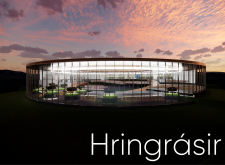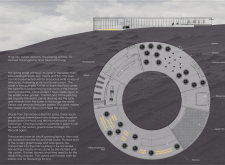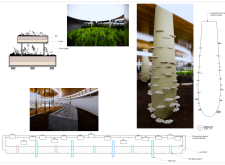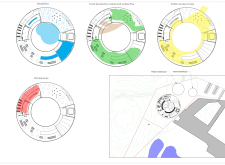5 key facts about this project
The interior layout facilitates a flow that encourages collaboration and learning, with spaces organized around a central courtyard. This design not only provides a visual and physical connection between different functions but also fosters a sense of community among users.
Integration of Sustainable Practices
A defining feature of Hringrásir is its innovative use of local geothermal resources. The design incorporates a hot spring oven, utilizing geothermal heat for cooking, thus minimizing energy consumption and reinforcing the project’s commitment to sustainability. The architecture showcases a water management system that recycles water used in the kitchen to nourish aquaponics and other agricultural systems. This interconnected approach enhances efficiency and reflects the design's focus on the principles of a circular economy.
The use of vertical farming elements maximizes space while allowing for diverse agricultural outputs. By integrating aquaponics and composting systems, the project exemplifies how architecture can support local food production and waste reduction. These methods not only serve practical functions but also highlight the relationship between architecture and the natural ecosystem.
Unique Design Considerations
The architectural design of Hringrásir emphasizes biophilic elements, ensuring that users are connected to nature through ample natural light and views. The circular shape serves multiple purposes, from improving social cohesion to optimizing energy efficiency. It stands as a model for how architecture can accommodate various agricultural practices while fostering a strong community base.
Attention to materiality is reflected in the selection of sustainable materials such as wood and local aggregates, promoting a low environmental impact. This choice not only enhances the aesthetic quality of the building but also aligns with the overarching theme of sustainability.
For those interested in a deeper understanding of the project, exploring the architectural plans, architectural sections, and architectural designs can provide further insights into how these considerations have been integrated into the overall architectural idea. The Hringrásir project serves as an example of how modern architecture can effectively address contemporary sustainability challenges while fostering community interaction.


























